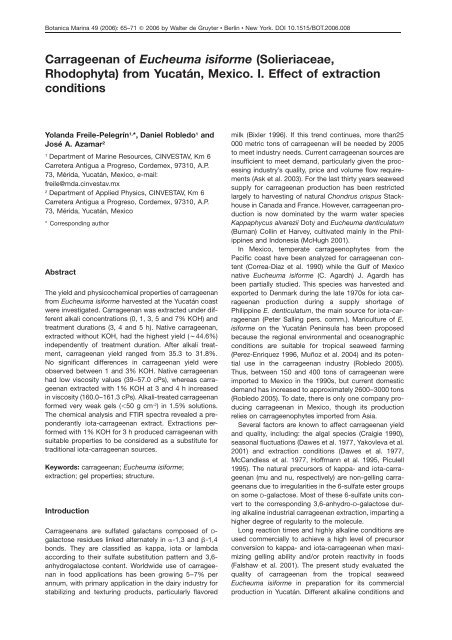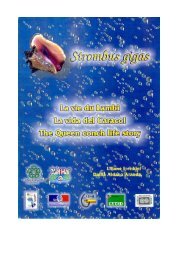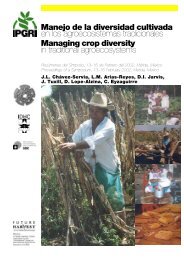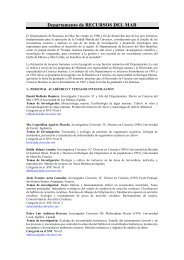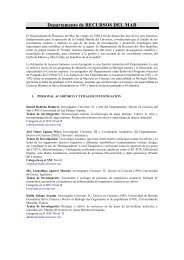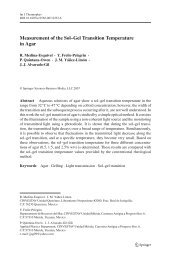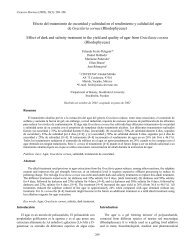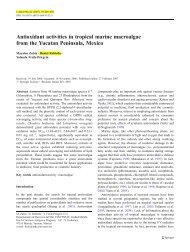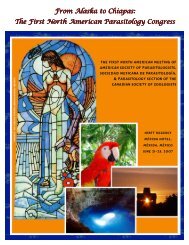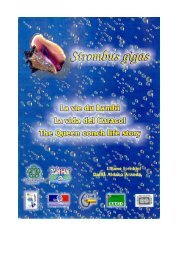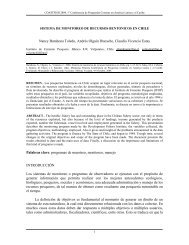Carrageenan of Eucheuma isiforme (Solieriaceae, Rhodophyta ...
Carrageenan of Eucheuma isiforme (Solieriaceae, Rhodophyta ...
Carrageenan of Eucheuma isiforme (Solieriaceae, Rhodophyta ...
You also want an ePaper? Increase the reach of your titles
YUMPU automatically turns print PDFs into web optimized ePapers that Google loves.
Article in press - uncorrected pro<strong>of</strong><br />
Botanica Marina 49 (2006): 65–71 2006 by Walter de Gruyter • Berlin • New York. DOI 10.1515/BOT.2006.008<br />
<strong>Carrageenan</strong> <strong>of</strong> <strong>Eucheuma</strong> <strong>isiforme</strong> (<strong>Solieriaceae</strong>,<br />
<strong>Rhodophyta</strong>) from Yucatán, Mexico. I. Effect <strong>of</strong> extraction<br />
conditions<br />
Yolanda Freile-Pelegrín 1, *, Daniel Robledo 1 and<br />
José A. Azamar 2<br />
1 Department <strong>of</strong> Marine Resources, CINVESTAV, Km 6<br />
Carretera Antigua a Progreso, Cordemex, 97310, A.P.<br />
73, Mérida, Yucatán, Mexico, e-mail:<br />
freile@mda.cinvestav.mx<br />
2 Department <strong>of</strong> Applied Physics, CINVESTAV, Km 6<br />
Carretera Antigua a Progreso, Cordemex, 97310, A.P.<br />
73, Mérida, Yucatán, Mexico<br />
* Corresponding author<br />
Abstract<br />
The yield and physicochemical properties <strong>of</strong> carrageenan<br />
from <strong>Eucheuma</strong> <strong>isiforme</strong> harvested at the Yucatán coast<br />
were investigated. <strong>Carrageenan</strong> was extracted under different<br />
alkali concentrations (0, 1, 3, 5 and 7% KOH) and<br />
treatment durations (3, 4 and 5 h). Native carrageenan,<br />
extracted without KOH, had the highest yield (;44.6%)<br />
independently <strong>of</strong> treatment duration. After alkali treatment,<br />
carrageenan yield ranged from 35.3 to 31.8%.<br />
No significant differences in carrageenan yield were<br />
observed between 1 and 3% KOH. Native carrageenan<br />
had low viscosity values (39–57.0 cPs), whereas carrageenan<br />
extracted with 1% KOH at 3 and 4 h increased<br />
in viscosity (160.0–161.3 cPs). Alkali-treated carrageenan<br />
formed very weak gels (-50 g cm -2 ) in 1.5% solutions.<br />
The chemical analysis and FTIR spectra revealed a preponderantly<br />
iota-carrageenan extract. Extractions performed<br />
with 1% KOH for 3 h produced carrageenan with<br />
suitable properties to be considered as a substitute for<br />
traditional iota-carrageenan sources.<br />
Keywords: carrageenan; <strong>Eucheuma</strong> <strong>isiforme</strong>;<br />
extraction; gel properties; structure.<br />
Introduction<br />
<strong>Carrageenan</strong>s are sulfated galactans composed <strong>of</strong> Dgalactose<br />
residues linked alternately in a-1,3 and b-1,4<br />
bonds. They are classified as kappa, iota or lambda<br />
according to their sulfate substitution pattern and 3,6anhydrogalactose<br />
content. Worldwide use <strong>of</strong> carrageenan<br />
in food applications has been growing 5–7% per<br />
annum, with primary application in the dairy industry for<br />
stabilizing and texturing products, particularly flavored<br />
milk (Bixler 1996). If this trend continues, more than25<br />
000 metric tons <strong>of</strong> carrageenan will be needed by 2005<br />
to meet industry needs. Current carrageenan sources are<br />
insufficient to meet demand, particularly given the processing<br />
industry’s quality, price and volume flow requirements<br />
(Ask et al. 2003). For the last thirty years seaweed<br />
supply for carrageenan production has been restricted<br />
largely to harvesting <strong>of</strong> natural Chondrus crispus Stackhouse<br />
in Canada and France. However, carrageenan production<br />
is now dominated by the warm water species<br />
Kappaphycus alvarezii Doty and <strong>Eucheuma</strong> denticulatum<br />
(Burnan) Collin et Harvey, cultivated mainly in the Philippines<br />
and Indonesia (McHugh 2001).<br />
In Mexico, temperate carrageenophytes from the<br />
Pacific coast have been analyzed for carrageenan content<br />
(Correa-Díaz et al. 1990) while the Gulf <strong>of</strong> Mexico<br />
native <strong>Eucheuma</strong> <strong>isiforme</strong> (C. Agardh) J. Agardh has<br />
been partially studied. This species was harvested and<br />
exported to Denmark during the late 1970s for iota carrageenan<br />
production during a supply shortage <strong>of</strong><br />
Philippine E. denticulatum, the main source for iota-carrageenan<br />
(Peter Salling pers. comm.). Mariculture <strong>of</strong> E.<br />
<strong>isiforme</strong> on the Yucatán Peninsula has been proposed<br />
because the regional environmental and oceanographic<br />
conditions are suitable for tropical seaweed farming<br />
(Perez-Enriquez 1996, Muñoz et al. 2004) and its potential<br />
use in the carrageenan industry (Robledo 2005).<br />
Thus, between 150 and 400 tons <strong>of</strong> carrageenan were<br />
imported to Mexico in the 1990s, but current domestic<br />
demand has increased to approximately 2600–3000 tons<br />
(Robledo 2005). To date, there is only one company producing<br />
carrageenan in Mexico, though its production<br />
relies on carrageenophytes imported from Asia.<br />
Several factors are known to affect carrageenan yield<br />
and quality, including: the algal species (Craigie 1990),<br />
seasonal fluctuations (Dawes et al. 1977, Yakovleva et al.<br />
2001) and extraction conditions (Dawes et al. 1977,<br />
McCandless et al. 1977, H<strong>of</strong>fmann et al. 1995, Piculell<br />
1995). The natural precursors <strong>of</strong> kappa- and iota-carrageenan<br />
(mu and nu, respectively) are non-gelling carrageenans<br />
due to irregularities in the 6-sulfate ester groups<br />
on some D-galactose. Most <strong>of</strong> these 6-sulfate units convert<br />
to the corresponding 3,6-anhydro-D-galactose during<br />
alkaline industrial carrageenan extraction, imparting a<br />
higher degree <strong>of</strong> regularity to the molecule.<br />
Long reaction times and highly alkaline conditions are<br />
used commercially to achieve a high level <strong>of</strong> precursor<br />
conversion to kappa- and iota-carrageenan when maximizing<br />
gelling ability and/or protein reactivity in foods<br />
(Falshaw et al. 2001). The present study evaluated the<br />
quality <strong>of</strong> carrageenan from the tropical seaweed<br />
<strong>Eucheuma</strong> <strong>isiforme</strong> in preparation for its commercial<br />
production in Yucatán. Different alkaline conditions and<br />
2006/56
Article in press - uncorrected pro<strong>of</strong><br />
66 Y. Freile-Pelegrín et al.: Yield and physicochemical properties <strong>of</strong> carrageenan from <strong>Eucheuma</strong> <strong>isiforme</strong><br />
treatment duration were used to extract carrageenan.<br />
Native and alkali-treated carrageenan properties (i.e.,<br />
yield, gel strength and viscosity) are described. Structural<br />
analyses were also done, including sulfate, 3,6-anhydro-<br />
D-galactose content and infrared spectroscopy.<br />
Materials and methods<br />
Sample collection and carrageenan extraction<br />
<strong>Eucheuma</strong> <strong>isiforme</strong> was collected manually from natural<br />
beds at Dzilam de Bravo (218039000 N, 888579500 W),<br />
Yucatán, Mexico, in May 1998. Thalli were washed thoroughly<br />
with tap water to remove excess salts and sand,<br />
oven-dried at 608C and then milled prior to carrageenan<br />
extraction. The collected algal material was free <strong>of</strong> epiphytes<br />
and thus considered ‘‘pure seaweed’’.<br />
The carrageenan from <strong>Eucheuma</strong> <strong>isiforme</strong> was<br />
obtained using the hot alkaline extraction method described<br />
by Stanley (1987), with some modifications. Alkali<br />
concentrations between 0 and 7% KOH and treatment<br />
duration from 3 to 5 h were used. Dry samples (5 g) were<br />
rehydrated at room temperature for 12 h in the corresponding<br />
KOH solution (0, 1, 3, 5 and 7%), followed by<br />
the hot alkali extraction at 858C at one <strong>of</strong> three treatment<br />
durations (3, 4 or 5 h). The extract was mixed with diatomaceous<br />
earth (Celite), pressure filtered and the filtrate<br />
neutralized to pH 8.9 with 5 M HCl prior to the recovery<br />
<strong>of</strong> the carrageenan from the solution.<br />
<strong>Carrageenan</strong> was precipitated by slowly adding 250 ml<br />
<strong>of</strong> 2% Cetavlon (hexadecyl-tri-methylammonium bromide)<br />
in 9:1 (v/v) distilled water:acetone according to<br />
Craigie and Leigh (1978) and Chopin et al. (1990), and<br />
recovered over filter paper in vacuo. To remove Cetavlon<br />
residues, the carrageenan fibers were carefully washed<br />
three times with 63 ml <strong>of</strong> 95% ethanol saturated with<br />
sodium acetate. Sodium acetate residues were then<br />
removed by three final washes with 95% ethanol. <strong>Carrageenan</strong><br />
was dried at 608C for 24 h, weighed to calculate<br />
the percent yield, and milled. Extractions and<br />
carrageenan analyses were performed in triplicate for<br />
each treatment.<br />
Rheological and chemical analysis<br />
Rheological properties were measured for the carrageenans<br />
extracted at different alkali concentrations and<br />
treatment duration. Water gel strength was determined<br />
according to Freile-Pelegrín and Robledo (1997) in a<br />
1.5% w/v carrageenan solution using a Nikansui Shiki<br />
gelometer with 1 cm 2 plunger (Kiya Seisakusho, Tokyo,<br />
Japan). Viscosity was measured using a Cole Parmer Viscosimeter<br />
(Vernon Hills, USA) with a low centipoise adapter<br />
at 20 rpm (spindle number 8) on 18 ml samples <strong>of</strong> a<br />
1.5% carrageenan solution. Samples were homogenized<br />
and allowed to stabilize in a recirculating bath at 758C.<br />
Sulfate content was measured turbidimetrically after<br />
hydrolyzing 25 mg carrageenan in sealed tubes for 12 h<br />
in 1N HCl at 1058C (Jackson and McCandless 1978). The<br />
3,6 anhydrogalactose content (3,6 AG) was determined<br />
following Matsuhiro and Zanlungo (1983) and total carbohydrates<br />
were obtained by the phenol sulfuric acid<br />
method (Dubois et al. 1956). These values were used to<br />
calculate the molar ratio <strong>of</strong> galactose to 3,6 AG to ester<br />
sulfate. The galactose content is expressed as total carbohydrate<br />
content in the algae minus the corresponding<br />
3,6 AG content for each extraction condition.<br />
<strong>Carrageenan</strong>s extracted at different alkali and treatment<br />
duration treatments were analyzed by Fourier transformed<br />
infrared spectroscopy (FTIR). About 4.0 mg <strong>of</strong><br />
carrageenan were mixed thoroughly in a mortar with<br />
200 mg <strong>of</strong> potassium bromide until homogenized. The<br />
infrared spectra <strong>of</strong> native and alkali-modified carrageenan<br />
were recorded on a ThermoNicolet Nexus 670 FTIR<br />
spectrometer (Madison, WI, USA) equipped with a DTGS<br />
KBr detector and purge gas generator at a spectral<br />
resolution <strong>of</strong> 0.09 cm -1 and a wave length precision <strong>of</strong><br />
0.01 cm -1 . Each spectrum (32 scans) was acquired at a<br />
resolution <strong>of</strong> 4 cm -1 .<br />
Statistical analysis<br />
Data were tested for normality (Kolmogorov-Smirnov)<br />
and homogeneity <strong>of</strong> group variances (Bartlett’s test)<br />
using statistical s<strong>of</strong>tware (Statistica 6.0, Stats<strong>of</strong>t). When<br />
necessary, variables were log x or log (xq1) transformed<br />
to meet these assumptions. The interactions <strong>of</strong> KOH<br />
concentration and treatment duration with carrageenan<br />
properties were assessed with a two-way analysis <strong>of</strong> variance<br />
(ANOVA). A post hoc analysis <strong>of</strong> the means using<br />
the Tukey (HSD) test was done to compare between<br />
treatments, and a Pearson’s correlation coefficient was<br />
used to determine the correlation between carrageenan<br />
properties.<br />
Results<br />
<strong>Carrageenan</strong> content and properties<br />
<strong>Eucheuma</strong> <strong>isiforme</strong> extracted without KOH (native carrageenan)<br />
had the highest yields, with 44.5% at 3 h,<br />
44.1% at 4 h and 45.3% at 5 h. No significant differences<br />
between treatment durations at 3 and 4 h were found<br />
(F 1,4s1.71, p)0.05) (Figure 1). <strong>Carrageenan</strong> yield<br />
decreased after alkali treatment using 1 and 3% KOH,<br />
with values ranging from 31.8 to 35.3%. Yield increased<br />
after treatment with 5 and 7% KOH, with a maximum<br />
value <strong>of</strong> 43.2% at 7% KOH for 5 h.<br />
Figure 1 <strong>Eucheuma</strong> <strong>isiforme</strong>: carrageenan yields <strong>of</strong> native and<br />
alkali treated carrageenans obtained at different treatment durations:<br />
3 h (white bar), 4 h (cross-hatched bar) and 5 h (black bar).<br />
Means"SD; ns3.
Article in press - uncorrected pro<strong>of</strong><br />
Y. Freile-Pelegrín et al.: Yield and physicochemical properties <strong>of</strong> carrageenan from <strong>Eucheuma</strong> <strong>isiforme</strong> 67<br />
Figure 2 <strong>Eucheuma</strong> <strong>isiforme</strong>: carragenan properties <strong>of</strong> native<br />
and alkali treated carrageenans obtained at different treatment<br />
durations: 3 h (white bar), 4 h (cross-hatched bar) and 5 h (black<br />
bar).<br />
(A) Viscosity, (B) sulfate content, (C) 3,6 AG content. Means"SD;<br />
ns3.<br />
<strong>Carrageenan</strong> viscosities are shown in Figure 2A. Native<br />
carrageenan showed significant differences (F 2,6s347.9,<br />
p-0.01) in viscosities between treatment durations at<br />
3 h (57.0"0.9 cPs), 4 h (41.6"0.9 cPs) and 5 h<br />
(39.0"0.9 cPs). The 1% KOH treatment resulted in a tw<strong>of</strong>old<br />
increase in viscosity in comparison to native carrageenan.<br />
<strong>Carrageenan</strong> viscosity at 3 h was 160.0 cPs and<br />
for 4 h treatment duration it was 161.3 cPs, whereas at<br />
5 h a 21.9% reduction in viscosity was observed. At 3%<br />
KOH, viscosities decreased by 38.8% at 3–4 h and by<br />
53.1% at 5 h. Extraction at 5 and 7% KOH produced<br />
carrageenan with viscosities below 50 cPs. An inverse<br />
relationship between carrageenan yield and viscosity was<br />
observed for all treatments (rs-0.63 for 3 h; rs-0.79 for<br />
4h;rs-0.79 for 5 h; p-0.01). Alkali-treated carrageenan<br />
formed s<strong>of</strong>t gels (-50gcm -2 ) while native carrageenan<br />
did not gel at all.<br />
<strong>Carrageenan</strong> sulfate content is shown in Figure 2B.<br />
Native carrageenan sulfate content varied from 32.3 to<br />
34.7% with no significant differences between treatment<br />
durations (F 2, 5s1.68, p)0.05). In general, alkali treatment<br />
reduced carrageenan sulfate content by ;40% at 3 h<br />
and ;22% at 4 h, with values ranging from 16.6 to<br />
24.5%. No significant decrease in sulfate content was<br />
observed in carrageenan extracted with alkali for 5 h in<br />
comparison to native carrageenan (p)0.05).<br />
<strong>Carrageenan</strong> 3,6 AG content is shown in Figure 2C.<br />
The lowest 3,6 AG contents (26.3–27.47%) were recorded<br />
for the native carrageenan, with no significant difference<br />
between treatment durations at 3 and 4 h (F 1,4s<br />
0.013, p)0.05). An increase <strong>of</strong> 14% was observed after<br />
alkali treatment (contents ranging from 29.2 to 33.0%).<br />
The highest 3,6 AG contents were recorded in carrageenan<br />
extracted at 3 h and decreased as treatment duration<br />
increased (4–5 h), independently <strong>of</strong> KOH concentration.<br />
A negative correlation was noted between carrageenan<br />
yield and 3,6 AG content (rs-0.72 for 3 h, p-0.01; rs<br />
-0.51 for 4 h, p-0.05; rs-0.53 for 5 h, p-0.05). A clear<br />
inverse relationship was observed between 3,6 AG and<br />
sulfate contents at 3 h (rs-0.68, p-0.01) and 4 h (rs<br />
-0.55, p-0.05), but not at 5 h.<br />
The individual and combined effects <strong>of</strong> KOH concentration<br />
and treatment duration on carrageenan properties<br />
are shown in Table 1. Alkali concentration and treatment<br />
duration had a significant interaction effect on viscosity<br />
and sulfate content.<br />
Molar ratios<br />
Molar ratios <strong>of</strong> galactose to 3,6 AG to ester sulfate were<br />
calculated based on the total carbohydrate content in the<br />
algae (54.5%) (Table 2). Native carrageenan molar ratios<br />
were similar across treatment durations. Molar ratios varied<br />
after alkali treatment with an increase in 3,6 AG and<br />
a decrease in sulfate. This pattern was more evident for<br />
3hthan4htreatment duration, across all KOH concentrations.<br />
It is noteworthy that for 5 h treatment duration<br />
molar ratios were similar to those obtained for native<br />
carrageenan.<br />
FTIR spectroscopy<br />
The FTIR spectra for the native and alkali-treated carrageenan<br />
from <strong>Eucheuma</strong> <strong>isiforme</strong> are shown in Figure 3.<br />
All spectra displayed an absorption band at 1220–1240<br />
cm -1 related to sulfation level (Stanci<strong>of</strong>f and Stanley<br />
1969). A particularly intense signal was recorded in all<br />
samples at 803–805 cm -1 , which is specific to 3,6-anhydrogalactose-2-sulfate.<br />
Another signal was observed at<br />
845–847 cm -1 (attributed to galactose-4-sulfate). Peaks<br />
were also observed at 965–975 cm -1 in all samples (3linked<br />
b-D-galactose 4-sulfate and 4-linked a-D-galactose<br />
2-sulfate). In general, the carrageenan from E.<br />
<strong>isiforme</strong> extracted at 5 h had the highest intensities at<br />
this signal (peak). The intense signal observed around<br />
930 cm -1 was consistent with the presence <strong>of</strong> 3,6 AG<br />
(Stanci<strong>of</strong>f and Stanley 1969). A slight intensity increase<br />
at this peak was evident between the native and alkalitreated<br />
carrageenans implying either absence or undetectable<br />
levels <strong>of</strong> the precursor, 1,4-linked galactose-6-sulfate.<br />
The ratio between 805 and 845 cm -1 absorption bands<br />
in FTIR spectra was calculated (Rochas et al. 1986,
Article in press - uncorrected pro<strong>of</strong><br />
68 Y. Freile-Pelegrín et al.: Yield and physicochemical properties <strong>of</strong> carrageenan from <strong>Eucheuma</strong> <strong>isiforme</strong><br />
Table 1 <strong>Eucheuma</strong> <strong>isiforme</strong>: two-way analysis <strong>of</strong> variance for carrageenan yield, viscosity, sulfate content and 3,6 AG.<br />
Variable Sums <strong>of</strong> Degrees <strong>of</strong> F-value p-value<br />
squares freedom<br />
Yield<br />
A 211.90 4 92.23 -0.001*<br />
B 18.58 2 0.86 ns<br />
A=B 1.95 8 1.49 ns<br />
Viscosity<br />
A 0.59 4 78.22 -0.001*<br />
B 0.10 2 1.73 ns<br />
A=B 0.01 8 386.63 -0.001*<br />
Sulfate content<br />
A 0.04 4 4.49 0.005*<br />
B 0.12 2 22.93 -0.001*<br />
A=B 0.01 8 43.39 -0.001*<br />
3,6 AG content<br />
A 0.00 4 7.17 0.002*<br />
B 0.00 2 6.34 0.004*<br />
A=B 0.00 8 0.57 ns<br />
AsKOH concentration; Bstreatment duration; A=BsKOH concentration and treatment duration interaction.<br />
* Highly significant (p-0.001); nssnot significant (p)0.05).<br />
Correa-Díaz et al. 1990, Pereira and Mesquita 2003) and<br />
used as a qualitative parameter to determine the degree<br />
<strong>of</strong> iota/kappa hybridization <strong>of</strong> the native and alkali-treated<br />
samples. The ratio for native carrageenan extracted<br />
at 3 h and 4 h treatment duration was 0.65. Native carrageenan<br />
extracted at 5 h had a ratio similar to those<br />
obtained for all alkali treated carrageenan (1.00).<br />
Discussion<br />
The native carrageenan yields <strong>of</strong> <strong>Eucheuma</strong> <strong>isiforme</strong> from<br />
Yucatán were similar to those obtained by Dawes et al.<br />
(1977) from Florida material. In the present study, yield<br />
decreased as alkali concentration increased, which may<br />
be related to degradation <strong>of</strong> the polysaccharide resulting<br />
from the alkali concentration used. Dawes et al. (1977)<br />
reported higher carrageenan yields after alkali transformation<br />
(59.7%) than in the present results, though Perez-<br />
Enríquez (1996) obtained similar yields from E. <strong>isiforme</strong><br />
from Yucatán extracted with the same method described<br />
in Dawes et al. (1997).<br />
<strong>Carrageenan</strong> viscosity increased after alkali modification.<br />
However, a gradual decrease in this parameter was<br />
observed. These viscosity values are in the ranges <strong>of</strong><br />
those reported for <strong>Eucheuma</strong> <strong>isiforme</strong> from Florida<br />
(Dawes et al. 1977) and for other iota-producing species<br />
(Azanza-Corrales and Sa-a 1990, Brenden and Bird<br />
Table 2 <strong>Eucheuma</strong> <strong>isiforme</strong>: molar ratios <strong>of</strong> sugar residues and<br />
sulfate content found in carrageenan extracted under the experimental<br />
conditions.<br />
KOH (%) Molar ratio <strong>of</strong> galactose:3,6 AG:sulfate<br />
3h 4h 5h<br />
0 1:0.73:2.27 1:0.73:2.40 1:0.73:2.20<br />
1 1:1.00:1.67 1:0.92:1.53 1:0.78:2.21<br />
3 1:1.00:1.54 1:0.92:1.92 1:0.80:2.28<br />
5 1:1.00:1.54 1:0.92:1.84 1:0.80:2.64<br />
7 1:1.00:1.48 1:0.92:1.92 1:0.80:2.41<br />
1994). The KOH concentrations above 1% used in the<br />
present study may have caused carrageenan degradation,<br />
with an evident decrease in viscosity. The hot<br />
alkaline extraction operations inevitably involve some<br />
degradation <strong>of</strong> the polysaccharide due to the rigors (heat,<br />
alkalinity) <strong>of</strong> processing (Stanley 1987). Although carrageenans<br />
are reasonably stable under alkaline conditions,<br />
severe conditions, such as KOH concentrations )3%<br />
and extended treatment duration could promote depolymerisation<br />
<strong>of</strong> the carrageenan (Critchley, pers.<br />
comm.). Similar results were found by Dawes et al. (1977)<br />
for E. <strong>isiforme</strong> from Florida, where high lime concentrations<br />
and duration produced a drop in carrageenan gel<br />
strength and viscosity.<br />
Native carrageenan sulfate contents are within the<br />
range for iota-producing <strong>Eucheuma</strong> species (Cheney et<br />
al. 1987, Santos 1989, Fostier et al. 1992). Both alkali<br />
concentration and treatment duration significantly affected<br />
sulfate content (Table 1), with maximum sulfate reduction<br />
occurring at 3 h for all the alkali concentrations<br />
tested (Figure 2B). The 3,6 AG contents in alkali-treated<br />
carrageenan from <strong>Eucheuma</strong> <strong>isiforme</strong> were higher than<br />
previously reported for this species (26%) and for E.<br />
spinosum J. Ag. (nom. illeg.) (25.3%) by Fostier et al.<br />
(1992). In contrast, Dawes et al. (1977) reported lower<br />
values for Floridian E. <strong>isiforme</strong> (19.4%). The present data<br />
for 3,6 AG contents in carrageenan from E. <strong>isiforme</strong> were<br />
also higher than those reported for other iota-producing<br />
seaweeds precipitated with Cetavlon wi.e., 15.7% in<br />
Agardhiella subulata (C. Agardh) Kraft et Wynne, Chopin<br />
et al. 1990; and 14.5% in Cryptonemia crenulata (J.<br />
Agardh) J. Agardh (Saito and de Oliveira 1990)x. The KOH<br />
concentration and treatment duration significantly affected<br />
sulfate content and 3,6 AG content in the carrageenan<br />
extracted (Table 1). An inverse correlation between sulfate<br />
and 3,6 AG was observed, except at 5 h treatment<br />
duration. Under these conditions, there is no evidence<br />
for a transformation <strong>of</strong> the precursor since neither sulfate<br />
reduction nor increase in 3,6 AG occurs. Probably, severe<br />
extraction conditions, such as strong alkali concentration<br />
and extended treatment duration, affect carrageenan.
Article in press - uncorrected pro<strong>of</strong><br />
Y. Freile-Pelegrín et al.: Yield and physicochemical properties <strong>of</strong> carrageenan from <strong>Eucheuma</strong> <strong>isiforme</strong> 69<br />
Figure 3 <strong>Eucheuma</strong> <strong>isiforme</strong>: FTIR spectra <strong>of</strong> native and alkali<br />
treated carrageenans obtained at 3, 4 and 5 h.<br />
(A) 0% KOH, (B) 1% KOH, (C) 3% KOH, (D) 5% KOH, (E) 7%<br />
KOH.<br />
Nevertheless, other analytical techniques may be used to<br />
corroborate this.<br />
The native carrageenan from <strong>Eucheuma</strong> <strong>isiforme</strong> from<br />
Yucatán did not gel, which agrees with previous reports<br />
for the species from Florida (Dawes et al. 1977). With<br />
alkali conversion, 3,6 AG content promotes double helix<br />
formation and thus gelation. Very weak carrageenan gels<br />
were produced in E. <strong>isiforme</strong> from Yucatán after alkali<br />
treatment (-50gcm -2 ). Similar values were reported by<br />
Santos (1989) for the same species (53 g cm -2 ), while<br />
higher values were found by Dawes et al. (1977) for modified<br />
carrageenan (318 g cm -2 ). However, comparison<br />
between these two studies is difficult because the former<br />
reported gel strength for carrageenan gels 2% w/v with<br />
potassium chloride (0.2).<br />
The FTIR spectra showed an intense signal at<br />
803–805 cm -1 , which is specific <strong>of</strong> iota carrageenan<br />
(Dawes et al. 1977). However, the signal at<br />
845–847 cm -1 corroborates the existence <strong>of</strong> a kappaand<br />
iota-carrageenan mixture (Chopin et al. 1990). All<br />
spectra exhibited a shoulder at 867 cm -1 , attributed to<br />
the sulfate group at C-6, indicating the presence <strong>of</strong> nucarrageenan,<br />
considered the biological precursor to iotacarrageenan<br />
(Bodeau-Bellion 1983). This was corroborated<br />
through chemical analysis that showed an<br />
increase in 3,6 AG content and a reduction in sulfate after<br />
alkali modification at 3 h and 4htreatment duration. The<br />
biological precursors <strong>of</strong> kappa and iota carrageenan (mu<br />
and nu, respectively) both contain a sulfate ester group<br />
at position C-6 <strong>of</strong> a 4-linked a-D-galactose unit with<br />
characteristic bands at 820 and 867 cm -1 , respectively<br />
(Bodeau-Bellion 1983, Chopin et al. 1990, Pereira and<br />
Mesquite 2003). In <strong>Eucheuma</strong> <strong>isiforme</strong> from Yucatán, nucarrageenan<br />
may, therefore, be the common precursor<br />
for both kappa- and iota-carrageenan since the predicted<br />
precursor <strong>of</strong> kappa-carrageenan (D-galactose-6-sulfate)<br />
was not detected (peak at 820 cm -1 ). Bellion et al. (1981)<br />
described this for the kappa-, iota- and nu-carrageenan<br />
family. The hybrid structure <strong>of</strong> kappa-, iota- and nu-carrageenan<br />
has also been reported in E. <strong>isiforme</strong> var. denudatum<br />
Cheney was E. nudum (Greer and Yaphe 1984)x<br />
and in Agardhiella subulata (Chopin et al. 1990). The peak<br />
at 867 cm -1 was not recorded in previous studies <strong>of</strong> carrageenan<br />
from E. <strong>isiforme</strong> (Lawson et al. 1973, Dawes et<br />
al. 1977). As Chopin et al. (1990) pointed out, the presence<br />
<strong>of</strong> a low abundance carrageenan component cannot<br />
be detected by IR spectroscopy, though FTIR<br />
spectroscopy is a much more powerful tool.<br />
The FTIR spectra and molar ratios indicated that the<br />
phycocolloids extracted from <strong>Eucheuma</strong> <strong>isiforme</strong> from<br />
Yucatán have a dominant iota-carrageenan which is<br />
similar to E. spinosum, a current commercial source <strong>of</strong><br />
iota-carrageenan (Deslandes et al. 1985). Theoretically,<br />
the molar ratio <strong>of</strong> galactose to 3,6 AG to ester sulfate for<br />
iota carrageenan is 1:1:2 (Anderson et al. 1973). In E.<br />
<strong>isiforme</strong> from Yucatán the galactose to 3,6 AG ratios<br />
increased after alkali modification, except for 5 h treatment<br />
duration. This pattern has been described by Lawson<br />
et al. (1973) and Dawes et al. (1977) for the same<br />
species, though E. <strong>isiforme</strong> from Yucatán had higher 3,6<br />
AG contents in both the native carrageenan (1:0.73) and<br />
alkali-treated carrageenan (1:1) (Dawes et al. 1977,<br />
1:0.4).<br />
In conclusion, <strong>Eucheuma</strong> <strong>isiforme</strong> from Yucatán may<br />
be a good source <strong>of</strong> relatively pure iota-carrageenan if<br />
extracted under certain conditions. Extraction with 1%<br />
KOH at 3 h produces carrageenan <strong>of</strong> sufficient quality to<br />
serve as a substitute for traditional carrageenan sources<br />
since sulfate levels fit the US Food and Drug Administration<br />
purity standard <strong>of</strong> 20–40% (dry weight) and meet the<br />
industrial requirements <strong>of</strong> minimum carrageenan yield<br />
and viscosity values <strong>of</strong> 39% (dry weight) and 5 cPs,<br />
respectively (Bixler 1996). Higher KOH concentrations at<br />
3 h and 4 h notably decrease viscosity, suggesting that<br />
alkali concentrations -1% should be investigated. Future
Article in press - uncorrected pro<strong>of</strong><br />
70 Y. Freile-Pelegrín et al.: Yield and physicochemical properties <strong>of</strong> carrageenan from <strong>Eucheuma</strong> <strong>isiforme</strong><br />
research should focus on use <strong>of</strong> E. <strong>isiforme</strong> carrageenan<br />
for industrial applications, as well as more detailed characterizations<br />
<strong>of</strong> carrageenan composition, perhaps<br />
through NMR spectroscopy.<br />
Acknowledgements<br />
We thank C. Chávez Quintal for her technical assistance during<br />
laboratory analysis. This study was supported by the projects<br />
CONACYT-SAGARPA 2002-C01-1057 and CONACYT 38490E.<br />
References<br />
Anderson, N.S., T.C.S. Dolan and D.A. Rees. 1973. <strong>Carrageenan</strong>s.<br />
Part VII. Polysaccharides from <strong>Eucheuma</strong> spinosum<br />
and <strong>Eucheuma</strong> cottonii. The covalent structure <strong>of</strong> i-carrageenan.<br />
J. Chem. Soc. Perkin Trans. 1: 2173–2176.<br />
Ask, E., A. Batibasaga, J.M. Zertuche-González and M. de San.<br />
2003. Three decades <strong>of</strong> Kappaphycus alvarezii (<strong>Rhodophyta</strong>)<br />
introduction to non-endemic location. Proc. Int. Seaweed<br />
Symp. 17: 49–57.<br />
Azanza-Corrales, R. and P. Sa-a. 1990. The farmed <strong>Eucheuma</strong><br />
species (Gigartinales, <strong>Rhodophyta</strong>) in Danajon Reef, Philippines:<br />
carrageenan properties. Hydrobiologia 204/205:<br />
521–525.<br />
Bellion, C., G.K. Hamer and W. Yaphe. 1981. Analysis <strong>of</strong> kappaiota<br />
hybrid carrageenans with kappa-carrageenase, iota-carrageenase<br />
and 13C-NMR. Proc. Int. Seaweed Symp. 10:<br />
379–384.<br />
Bixler, H.J. 1996. Recent developments in manufacturing and<br />
marketing carrageenan. Hydrobiologia 326/327: 35–57.<br />
Bodeau-Bellion, C. 1983. Analysis <strong>of</strong> carrageenan structure.<br />
Physiol. Vég. 21: 785–793.<br />
Brenden, P.Ch. and K.T. Bird. 1994. Effects <strong>of</strong> environmental factors<br />
on carrageenan from Gymnogongrus griffithsiae (Gigartinales,<br />
<strong>Rhodophyta</strong>). J. Appl. Phycol. 6: 371–380.<br />
Cheney, D.P., A.H. Luistro and P.M. Bradley. 1987. <strong>Carrageenan</strong><br />
analysis <strong>of</strong> tissue cultures and whole plants <strong>of</strong> Agardhiella<br />
subulata. Hydrobiologia 151/152: 161–166.<br />
Chopin, T., M.D. Hanisak, F.E. Koehn, J. Mollion and S. Moreau.<br />
1990. Studies on carrageenan and effects <strong>of</strong> seawater phosphorus<br />
concentration on carrageenan content and growth <strong>of</strong><br />
Agardhiella subulata (C. Agardh) Kraft and Wynne (Rhodophyceae,<br />
<strong>Solieriaceae</strong>). J. Appl. Phycol. 2: 3–16.<br />
Correa-Díaz, F., R. Aguilar-Rosas and L.E. Aguilar-Rosas. 1990.<br />
Infrared analysis <strong>of</strong> eleven carrageenophytes from Baja<br />
California, Mexico. Hydrobiologia 204/205: 609–614.<br />
Craigie, J.S. 1990. Cell walls. In: (K.M. Cole and R.G. Sheath,<br />
eds) Biology <strong>of</strong> the red algae. Cambridge University Press,<br />
Cambridge. pp. 221–258.<br />
Craigie, J.S. and C. Leigh. 1978. <strong>Carrageenan</strong> and agar. In: (J.A.<br />
Hellebust and J.A. Craigie, eds) Handbook <strong>of</strong> phycological<br />
methods: physiological and biochemical methods. Cambridge<br />
University Press, Cambridge. pp. 109–131.<br />
Dawes, C.J., N.F. Stanley and D.J. Stanci<strong>of</strong>f. 1977. Seasonal and<br />
reproductive aspects <strong>of</strong> plant chemistry and iota carrageenan<br />
from Floridian <strong>Eucheuma</strong> (<strong>Rhodophyta</strong>, Gigartinales).<br />
Bot. Mar. 20: 137–147.<br />
Deslandes, E., J.Y. Floc’h, C. Bodeau-Bellion, D. Brault and J.P.<br />
Braud. 1985. Evidence for i-carrageenans in Solieria chordalis<br />
(<strong>Solieriaceae</strong>) and Calliblepharis jubata, Calliblepharis<br />
ciliate, Cystoclonium purpureum (Rhodophyllidaceae). Bot.<br />
Mar. 28: 317–318.<br />
Dubois, M., K.A. Gilles, J.K. Hamilton, P.A. Roberts and F. Smith.<br />
1956. Colorimetric method for determination <strong>of</strong> sugar and<br />
related substances. Anal. Chem. 28: 350–356.<br />
Falshaw, R., H.J. Bixler and K. Johndro. 2001. Structure performance<br />
<strong>of</strong> commercial kappa-2 carrageenan. I. Structure<br />
analysis. Food Hydrocolloids 15: 441–452.<br />
Fostier, A.H., J.M. Kornprobst and G. Combaut. 1992. Chemical<br />
composition and rheological properties <strong>of</strong> carrageenans from<br />
two Senegalese <strong>Solieriaceae</strong> Anatheca montagnei Schmitz<br />
and Meristotheca senegalensis Feldmann. Bot. Mar. 35:<br />
351–355.<br />
Freile-Pelegrín, Y. and D. Robledo. 1997. Effects <strong>of</strong> season on<br />
the agar content and chemical characteristics <strong>of</strong> Gracilaria<br />
cornea from Yucatán, Mexico. Bot. Mar. 40: 285–290.<br />
Greer, C.W. and W. Yaphe. 1984. Enzymatic analysis <strong>of</strong> carrageenans:<br />
structure <strong>of</strong> carrageenan from <strong>Eucheuma</strong> nudum.<br />
Hydrobiologia 116/117: 563–567.<br />
H<strong>of</strong>fmann, R.A., D. Gidley, D. Cooke and W.J. Frith. 1995. Effect<br />
<strong>of</strong> isolation procedures on the molecular composition and<br />
physical properties <strong>of</strong> <strong>Eucheuma</strong> cottonii carrageenan. Food<br />
Hydrocolloids 9: 281–289.<br />
Jackson, S.G. and E.L. McCandless. 1978. Simple, rapid, turbidimetric<br />
determination <strong>of</strong> inorganic sulfate and/or protein.<br />
Analyt. Bio. 90: 802–808.<br />
Lawson, C.J., D.A. Rees, D.J. Stanci<strong>of</strong>f and N.F. Stanley. 1973.<br />
<strong>Carrageenan</strong>s. Part VIII. Repeating structures <strong>of</strong> galactan sulfates<br />
from Furcellaria fastigiata, Gigartina canaliculata, Gigartina<br />
chamissoi, Gigartina atropurpurea, Ahnfeltia durvillaei,<br />
Gymnogongrus furcellatus, <strong>Eucheuma</strong> cottonii, <strong>Eucheuma</strong><br />
spinosum, <strong>Eucheuma</strong> <strong>isiforme</strong>, <strong>Eucheuma</strong> uncinatum,<br />
Aghardhiella tenera, Pachymenia hymantophora, and Gloiopeltis<br />
cervicornis. J. Chem. Soc. Perkin I: 2177–2182.<br />
Matsuhiro, B. and A. Zanlungo. 1983. Colorimetric determination<br />
<strong>of</strong> 3,6-anhydrogalactose in polysaccharides from red seaweeds.<br />
Carbohydr. Res. 118: 276–279.<br />
McCandless, E., W.T. Okada, J.N.A. Lott, C.M. Vollmer and E.M.<br />
Gordon-Mills. 1977. Structural studies <strong>of</strong> Chondrus crispus:<br />
the effect <strong>of</strong> extraction <strong>of</strong> carrageenan. Can. J. Bot. 55:<br />
2053–2064.<br />
McHugh, D.J. 2001. Prospects for seaweed production in developing<br />
countries. FAO Fisheries Circular 986. Rome, Italy. pp<br />
28.<br />
Muñoz, J., Y. Freile-Pelegrín and D. Robledo. 2004. Mariculture<br />
<strong>of</strong> Kappaphycus alvarezii (<strong>Rhodophyta</strong>, <strong>Solieriaceae</strong>) color<br />
strains in tropical waters <strong>of</strong> Yucatán, Mexico. Aquaculture<br />
239: 161–177.<br />
Pereira, L. and J.F. Mesquita. 2003. Carrageenophytes <strong>of</strong> occidental<br />
Portuguese coast: 1-spectroscopic analysis in eight<br />
carrageenophytes from Buarcos bay. Biomol. Eng. 20:<br />
223–228.<br />
Pérez-Enríquez, R. 1996. Growth <strong>of</strong> <strong>Eucheuma</strong> <strong>isiforme</strong> (C.<br />
Agardh) J. Agardh on experimental rafts <strong>of</strong>f the coast <strong>of</strong><br />
Yucatán state, Mexico. J. Appl. Phycol. 8: 27–28.<br />
Piculell, L. 1995. Gelling carrageenans. In: (A.M. Stephen, ed.)<br />
Food polysaccharides and their applications. Marcel Dekker<br />
Inc., New York. pp. 205–244.<br />
Robledo, D. 2005. The seaweed resources <strong>of</strong> México. In: (A.T.<br />
Critchley and M. Ohno, eds) Seaweed resources <strong>of</strong> the world.<br />
JICA, Japan. pp. 331–342.<br />
Rochas, C., M. Lahaye and W. Yaphe. 1986. Sulfate content <strong>of</strong><br />
carrageenan and agar determined by infrared spectroscopy.<br />
Bot. Mar. 29: 335–340.<br />
Saito, R. and E.C. de Oliveira. 1990. Chemical screening <strong>of</strong> Brazilian<br />
marine algae producing carrageenans. Hydrobiologia<br />
204/205: 585–588.<br />
Santos, G.A. 1989. <strong>Carrageenan</strong>s <strong>of</strong> species <strong>of</strong> <strong>Eucheuma</strong> J.<br />
Agardh and Kappaphycus Doty (<strong>Solieriaceae</strong>, <strong>Rhodophyta</strong>).<br />
Aquat. Bot. 36: 55–67.<br />
Stanci<strong>of</strong>f, D.J. and N.F. Stanley. 1969. Infrared and chemical<br />
studies on algal polysaccharides. Proc. Int. Seaweed Symp.<br />
6: 595–609.<br />
Stanley, N. 1987. Production, properties and uses <strong>of</strong> carragee-
Article in press - uncorrected pro<strong>of</strong><br />
Y. Freile-Pelegrín et al.: Yield and physicochemical properties <strong>of</strong> carrageenan from <strong>Eucheuma</strong> <strong>isiforme</strong> 71<br />
nan. In: (D.J. McHugh, ed.) Production and utilization <strong>of</strong> products<br />
from commercial seaweeds. FAO Fisheries Technical<br />
Paper 288. pp. 116–146.<br />
Yakovleva, I.M., I.M. Yermak, E.A. Titlyanov, A.O. Baranova and<br />
V.P. Glazunov. 2001. Changes in growth rate, anatomy and<br />
polysaccharide content <strong>of</strong> a sterile form <strong>of</strong> Tichocarpus cri-<br />
nitus (Gmel.) Rupr. (<strong>Rhodophyta</strong>, Tichocarpaceace) grown<br />
under different photon irradiances in the sea <strong>of</strong> Japan, Russia.<br />
Bot. Mar. 44: 493–500.<br />
Received 20 June, 2005; accepted 30 November, 2005


